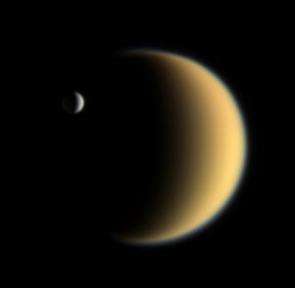NASA'S Cassini spacecraft captures Saturnian moon ballet

The cold, icy orbs of the Saturn system come to life in a slew of new movie clips showing the ringed planet's moons in motion.
Many denizens of the Saturn system wear a uniformly gray mantle of darkened ice, but not so for these two most fascinating of moons. The brightest body in the Solar System, Enceladus, is contrasted here against Titan's smoggy golden murk.
Ironically, what these two moons hold in common gives rise to their starkly contrasting colors. Both bodies are, to varying degrees, geologically active. For Enceladus, its southern polar vents emit a spray of icy particles that coats the small moon, giving it a clean, white veneer. On Titan, as-yet-undefined processes are supplying the atmosphere with methane and other chemicals that are broken down by sunlight, creating the thick yellow-orange haze that suffuses the atmosphere and, over geologic time, falls and coats the surface.
The thin, bluish haze along Titan’s limb is caused when sunlight is scattered by haze particles roughly the same size as the wavelength of blue light, or around 400 nanometers.
Images taken using red, green and blue spectral filters were combined to create this natural color view. The images were obtained on Feb. 5, 2006 using the Cassini spacecraft narrow-angle camera at a distance of 4.1 million kilometers (2.5 million miles) from Enceladus and 5.3 million kilometers (3.3 miles) from Titan. Resolution in the original images was 25 kilometers (16 miles) per pixel on Enceladus and 32 kilometers (20 miles) per pixel on Titan. The view has been magnified by a factor of two.
In addition to their drama and visual interest, scientists use these movies to refine their understanding of the orbits of Saturn's moons. Engineers at NASA's Jet Propulsion Laboratory, Pasadena, Calif., use the same images, and the orbital positions of the moons, to help them navigate the Cassini spacecraft, which is nearing the halfway mark of its four-year tour.
Pictures capturing several moons in one frame are often strikingly beautiful, especially when deliberately imaged in red, green and blue spectral filters, which allow scientists to create a color photo. One recent color image shows two of Saturn's most fascinating moons, icy-white Enceladus and orange, haze-enshrouded Titan.
The Cassini-Huygens mission is a cooperative project of NASA, the European Space Agency and the Italian Space Agency. The Jet Propulsion Laboratory, a division of the California Institute of Technology in Pasadena, manages the Cassini-Huygens mission for NASA's Science Mission Directorate, Washington, D.C. The imaging team consists of scientists from the US, England, France, and Germany. The imaging operations center and team lead (Dr. C. Porco) are based at the Space Science Institute in Boulder, Colo.
Source: Space Science Institute





















